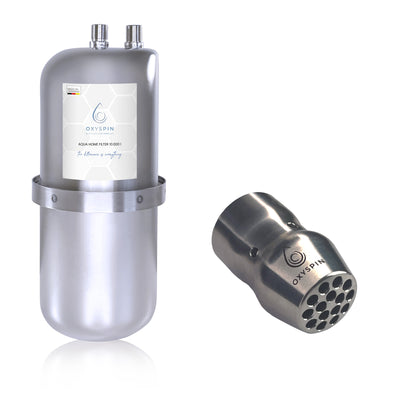Building/ technology & costs

"Hard", calcareous water becomes a building problem
In our modern tap water system, the drinking water is technically prepared in the waterworks and then pumped under high pressure through kilometers of straight water pipes, often made of plastic, into our houses. Above all, the bio-physical quality of our drinking water is severely affected.
Water molecules combine to form large molecular compounds (clusters).
Tap water is often very low in oxygen and thus the drinking freshness decreases noticeably. In addition, there are limescale deposits as a result of the reduced ability to dissolve. Limescale consists mainly of calcium and magnesium - two minerals that our body basically needs in the right solution.
Limescale that has not been dissolved causes enormous problems in building technology and high maintenance costs. "Hard water" has a very high calcium content and the probability of limescale deposits is correspondingly high. Limescale is deposited, for example, in water pipes, household appliances or on surfaces around the water extraction points. This leads to stains, blockages or even destroys fittings and essential parts of the device.
In addition to the typically white appearance, lime often also has a reddish tinge. As soon as lime has accumulated, iron and oxidized iron particles also settle in the lime layer; Rust settles on the pipes and pitting then poses a serious threat to our water lines. This occurs in particular when there are also leakage currents in the water pipes due to a lack of equipotential bonding and earthing.
Leaking water consumers, eg toilet cisterns, limescale deposits on heating coils, boilers, heat exchangers and the use of cleaning agents can cause significant additional costs each year. In addition, there are increased risks in cold or hot water, since the uneven surfaces of the lime deposits form an ideal breeding ground for bacteria, algae and other undesirable microorganisms, which can have very far-reaching consequences, especially for the landlord.
Typical problems caused by limescale deposits:
- Loss of water pressure due to reduced pipe inner diameter
- As a result, completely clogged water pipes
- Bacterial growth in water pipes carrying drinking water (biofilm)
- Higher energy costs due to limescale deposits on heating elements
- Frequent repairs and replacement of various household appliances
- pitting
That's exactly why we have the POWER MAGNETS without plastic, without chemicals, without electricity.



